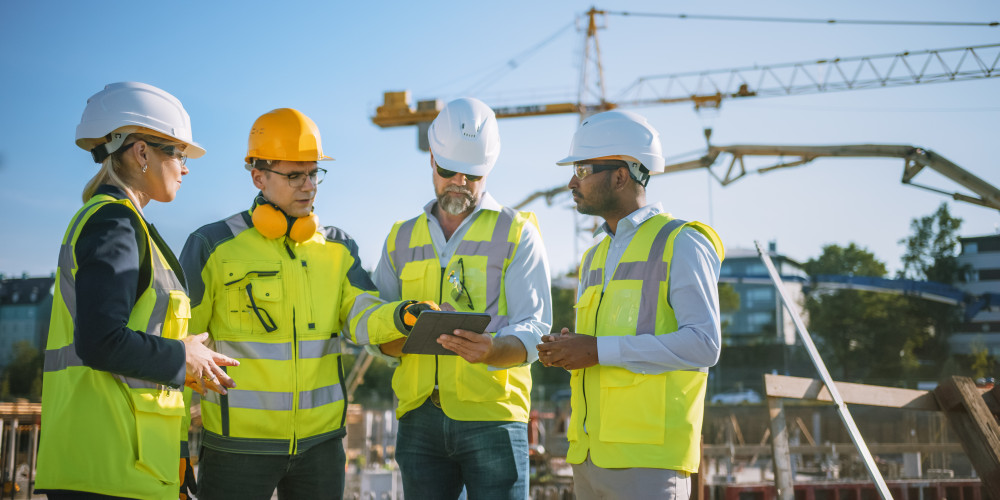20th January 2025
Implementing a Robust Safety Culture in Construction

In the construction industry, fostering a robust safety culture is essential to ensure the well-being of all personnel and the successful completion of projects. Leadership plays a pivotal role in cultivating a safety-first mindset, and practical steps can be taken to embed this culture on-site. Training courses such as the CITB Site Safety Plus suite of courses are instrumental in this endeavour.
The Importance of Leadership in Fostering a Safety-First Mindset
Effective leadership is the cornerstone of a strong safety culture. Leaders set the tone for safety standards and influence the attitudes and behaviours of their teams. By demonstrating a genuine commitment to safety, leaders can significantly reduce workplace accidents and build a safety-first culture.
Key aspects of leadership in promoting safety include:
- Leading by Example: When leaders consistently prioritise safety in their actions and decisions, it reinforces the importance of safety to all team members.
- Clear Communication: Articulating safety protocols and expectations clearly ensures that all workers understand their roles in maintaining a safe work environment.
- Proactive Approach: Anticipating potential safety issues and addressing them before they escalate demonstrates a commitment to continuous improvement in safety standards.
Practical Steps to Cultivate a Safety Culture On-Site
Establish Clear Safety Policies: Develop comprehensive safety guidelines that are easily accessible and understandable to all employees.
- Regular Training and Education: Provide ongoing training to ensure all team members are up-to-date with the latest safety practices and regulations.
- Encourage Open Communication: Create an environment where workers feel comfortable reporting safety concerns without fear of retribution.
- Conduct Regular Safety Audits: Perform frequent inspections to identify and mitigate potential hazards promptly.
- Recognise and Reward Safe Behaviour: Acknowledge individuals and teams who consistently adhere to safety protocols to reinforce positive behaviour.
The Role of Toolbox Talks in Promoting Safety and Mental Health
Toolbox talks are brief, focused discussions that address specific safety topics, including mental health, on construction sites. They serve as an effective platform to raise awareness, educate workers, and foster open communication about potential hazards and well-being.
- Regular Implementation: Conducting toolbox talks regularly keeps safety and mental health at the forefront of daily operations.
- Interactive Engagement: Encouraging participation during these talks helps identify concerns and promotes a collective approach to problem-solving.
- Mental Health Focus: Addressing mental health topics in toolbox talks can reduce stigma, encourage seeking support, and provide coping strategies for stress and anxiety.
Addressing Mental Health in Construction
The construction industry faces significant mental health challenges, with workers being at a higher risk for issues such as stress, anxiety, and depression. Factors contributing to this include high job demands, job insecurity, and a culture that may discourage discussing mental health concerns.
- Recognising Signs: It's crucial to be aware of indicators of mental health struggles among workers, such as changes in behaviour, decreased productivity, or withdrawal from social interactions.
- Providing Support: Offering access to mental health resources, such as counselling services or employee assistance programmes, can provide necessary support to those in need.
- Promoting Open Dialogue: Encouraging discussions about mental health through initiatives like toolbox talks can help reduce stigma and promote a supportive work environment.
The Lighthouse Club Construction Charity
The Lighthouse Construction Industry Charity provides emotional, physical, and financial well-being support to construction workers and their families. They offer a 24/7 Construction Industry Helpline, a free self-support app, and access to various training programmes through their Wellbeing Academy.
- Support Services: The charity provides confidential support on issues ranging from mental health and well-being to financial assistance, ensuring that workers have access to help when needed.
- Wellbeing Academy: Their Wellbeing Academy offers a variety of free construction-focused training programmes, including interactive well-being masterclasses and Mental Health First Aider courses, to promote a healthier workforce.
- Awareness Campaigns: Initiatives like the ‘Make it Visible’ campaign aim to raise awareness of mental health issues within the industry and signpost the support available to the construction community.
Training Courses to Support Safety Leadership
Several training programmes are designed to equip construction professionals with the necessary skills to manage and promote safety effectively:
- CITB Site Management Safety Training Scheme (SMSTS): A comprehensive five-day course aimed at site managers, covering all relevant legislation and other aspects that affect safe working in the building, construction, and civil engineering industries.
- CITB Site Supervisors’ Safety Training Scheme (SSSTS): A two-day course designed for those who have, or are about to acquire, supervisory responsibilities. It provides an understanding of health, safety, welfare, and environmental issues.
- CITB Site Environmental Awareness Training Scheme (SEATS): This course is designed to provide candidates with an introduction to environmental issues on construction sites.
- CITB Temporary Works Co-ordinator Training Course (TWCTC): A two-day course aimed at those who manage all forms of temporary works, focusing on the role of the Temporary Works Co-ordinator as defined in BS 5975-1:2024
- CITB Temporary Works Supervisor Training Course (TWSTC): A one-day course designed for those who have responsibility for supervising temporary works, providing a thorough knowledge of the role as defined in BS 5975-1:2024
Investing in these training programmes ensures that leaders and supervisors are well-equipped to foster a safety-first culture within their teams.
Conclusion
Implementing a robust safety culture in construction requires dedicated leadership and a commitment to continuous improvement. By leading by example, communicating clearly, and investing in targeted training programmes, construction leaders can cultivate an environment where safety is paramount, ultimately leading to more successful project outcomes and the well-being of all team members.

